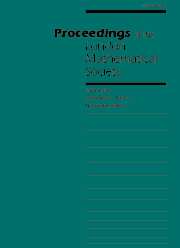Crossref Citations
This article has been cited by the following publications. This list is generated based on data provided by
Crossref.
Kuchment, Peter
2002.
Graph models for waves in thin structures.
Waves in Random Media,
Vol. 12,
Issue. 4,
p.
R1.
SOBOLEV, ALEXANDER V.
and
SOLOMYAK, MICHAEL
2002.
SCHRÖDINGER OPERATORS ON HOMOGENEOUS METRIC TREES: SPECTRUM IN GAPS.
Reviews in Mathematical Physics,
Vol. 14,
Issue. 05,
p.
421.
Solomyak, Michael
2003.
Function Spaces, Differential Operators and Nonlinear Analysis.
p.
161.
Solomyak, Michael
2003.
On approximation of functions from Sobolev spaces on metric graphs.
Journal of Approximation Theory,
Vol. 121,
Issue. 2,
p.
199.
Назаров, Сергей Александрович
and
Nazarov, Sergei Aleksandrovich
2004.
Эллиптические краевые задачи на гибридных областях.
Функциональный анализ и его приложения,
Vol. 38,
Issue. 4,
p.
55.
Nazarov, S. A.
2004.
Elliptic boundary value problems in hybrid domains.
Functional Analysis and Its Applications,
Vol. 38,
Issue. 4,
p.
283.
Kuchment, Peter
2004.
Quantum graphs: I. Some basic structures.
Waves in Random Media,
Vol. 14,
Issue. 1,
p.
S107.
Williams, F. W.
Howson, W. P.
and
Watson, A.
2004.
Application of the Wittrick—Williams algorithm to the Sturm—Liouville problem on homogeneous trees: a structural mechanics analogy.
Proceedings of the Royal Society of London. Series A: Mathematical, Physical and Engineering Sciences,
Vol. 460,
Issue. 2045,
p.
1243.
Solomyak, Michael
2004.
On the spectrum of the Laplacian on regular metric trees.
Waves in Random Media,
Vol. 14,
Issue. 1,
p.
S155.
Kurasov, Pavel
and
Nowaczyk, Marlena
2005.
Inverse spectral problem for quantum graphs.
Journal of Physics A: Mathematical and General,
Vol. 38,
Issue. 22,
p.
4901.
Garcia-Domingo, Josep L.
and
Soria, Javier
2005.
A decreasing rearrangement for functions on homogeneous trees.
European Journal of Combinatorics,
Vol. 26,
Issue. 2,
p.
201.
Pesenson, Isaac
2005.
Band limited functions on quantum graphs.
Proceedings of the American Mathematical Society,
Vol. 133,
Issue. 12,
p.
3647.
Pesenson, Isaac
2005.
Polynomial splines and eigenvalue approximations on quantum graphs.
Journal of Approximation Theory,
Vol. 135,
Issue. 2,
p.
203.
Pesenson, Isaac
2006.
Analysis of band-limited functions on quantum graphs.
Applied and Computational Harmonic Analysis,
Vol. 21,
Issue. 2,
p.
230.
Gnutzmann∥, Sven
and
Smilansky, Uzy
2006.
Quantum graphs: Applications to quantum chaos and universal spectral statistics.
Advances in Physics,
Vol. 55,
Issue. 5-6,
p.
527.
KovařÍk, Hynek
2008.
Weakly Coupled Schrödinger Operators on Regular Metric Trees.
SIAM Journal on Mathematical Analysis,
Vol. 39,
Issue. 4,
p.
1135.
Pinchover, Yehuda
Wolansky, Gershon
and
Zelig, Daphne
2008.
Spectral properties of Schrödinger operators on radial N-dimensional infinite trees.
Israel Journal of Mathematics,
Vol. 165,
Issue. 1,
p.
281.
BREUER, JONATHAN
and
FRANK, RUPERT L.
2009.
SINGULAR SPECTRUM FOR RADIAL TREES.
Reviews in Mathematical Physics,
Vol. 21,
Issue. 07,
p.
929.
Hislop, Peter D.
and
Post**, Olaf
2009.
Anderson localization for radial tree-like random quantum graphs.
Waves in Random and Complex Media,
Vol. 19,
Issue. 2,
p.
216.
Exner, Pavel
and
Lipovský, Jiří
2010.
On the absence of absolutely continuous spectra for Schrödinger operators on radial tree graphs.
Journal of Mathematical Physics,
Vol. 51,
Issue. 12,


